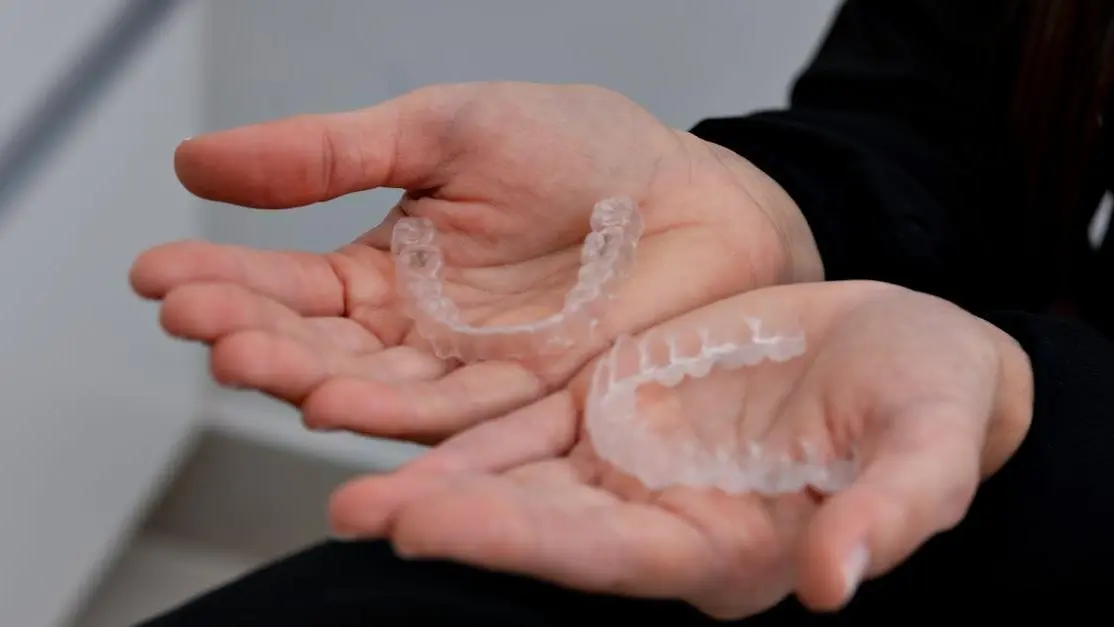When it comes to aligning your teeth, the choice between ceramic braces and Invisalign depends on your lifestyle, comfort preference, and orthodontic needs.
Ceramic braces are fixed onto teeth, offering durability and effective treatment for complex alignments, while blending aesthetically with your natural tooth color. Invisalign, on the other hand, uses clear, removable aligners that offer more flexibility and discreet appearance, ideal for those seeking a less noticeable option for mild to moderate corrections. Curious about costs, treatment time, and maintenance for each option? Keep reading to make an informed decision.
Understanding Ceramic Braces
Ceramic braces represent a popular and modern orthodontic solution. Known for their aesthetic appeal, they provide similar functionality to traditional metal braces but with a subtle difference in appearance.
What are Ceramic Braces Made Of?
Ceramic braces brackets are composed of a ceramic material that matches the natural color of your teeth. The wires can also be tooth-colored, which enhances their discreet nature. Despite their delicate look, ceramic braces are durable and built to withstand the daily activities of chewing and talking.
How Do Ceramic Braces Work?
Ceramic braces work similarly to metal braces by using a combination of brackets and wires to gradually shift your teeth into the desired position. Orthodontists tighten the wires over time, applying gentle pressure to move the teeth. Adjustments occur every few weeks to ensure progress.
Aesthetic Benefits of Ceramic Braces
The primary appeal of ceramic braces lies in their discretion. With their tooth-colored appearance, they attract less attention than their metal counterparts. This quality makes them particularly appealing to adults and teens who prioritize appearance during treatment.
- Subtle correction: They blend with your teeth, offering a natural look.
- Confidence boosting: Many users feel more comfortable smiling during treatment.
Considerations and Challenges
While ceramic braces offer a visually pleasing alternative, they are not without their challenges:
- Staining risk: The brackets can stain if not properly maintained. Foods and drinks, such as coffee or red wine, can discolor the brackets over time.
- Higher cost: Generally, ceramic braces tend to be more expensive compared to metal braces.
- Durability concerns: Although strong, the ceramic material is slightly less robust compared to metal braces.
Who Should Consider Ceramic Braces?
Individuals who are keen on a less noticeable orthodontic appliance often consider ceramic braces. This includes:
- Adults in professional settings
- Teens conscious of their appearance
- Anyone desiring effective treatment with a subtler look
Understanding Invisalign
Invisalign offers a groundbreaking approach to orthodontics with its clear aligners, virtually invisible to the casual observer.
What is Invisalign Made Of?
Invisalign aligners are crafted from a flexible thermoplastic material known as SmartTrack. This patented material is designed to fit snugly over your teeth while maintaining comfort and effectiveness in straightening.
How Does Invisalign Work?
Invisalign involves a series of custom-made aligners that gradually move your teeth into their desired positions. You wear each aligner for one to two weeks before switching to the next in the series. This step-by-step process allows for controlled movement of the teeth, guided by the treatment plan created by your orthodontist.
Aesthetic and Functional Benefits of Invisalign
Invisibility and removal flexibility are two significant benefits:
- Invisible design: The clear aligners offer a nearly invisible method of straightening your teeth.
- Ease of use: They are removable, allowing you to maintain oral hygiene easily by brushing and flossing without obstruction.
- No dietary restrictions: You can remove them during meals, so there are fewer restrictions on what you can eat.
Considerations and Challenges
Despite the appeal of Invisalign, it's important to understand some of its limitations:
- Compliance required: Success with Invisalign largely depends on wearing the aligners for 20-22 hours daily.
- Potential discomfort: Some users experience temporary discomfort as their teeth adjust to the new aligners.
- Can’t treat all cases: Complex dental problems may not be addressable by Invisalign alone.
Who Should Consider Invisalign?
Invisalign is particularly appealing for:
- Adults and teens seeking a virtually invisible treatment
- Individuals who desire flexibility in their treatment plan
- Those with mild to moderate dental issues
Comparing Ceramic Braces vs Invisalign
Seeking the right orthodontic treatment involves considering both ceramic braces and Invisalign based on your needs and lifestyle.
Effectiveness and Treatment Duration
Both treatment options are effective in correcting less severe alignment issues, but they differ in approach:
- Ceramic braces: Typically, these treat more complex cases effectively. They offer continuous pressure on teeth.
- Invisalign: Invisalign is efficient for mild to moderate issues but may require longer treatment times depending on consistent wear.
Cost Considerations
Cost can be a deciding factor:
- Ceramic braces often come at a slightly higher price point due to materials, but insurance sometimes covers part of the cost.
- Invisalign costs may vary depending on the number of aligners needed, typically costing slightly more than metal braces.
Comfort During Treatment
Comfort is a crucial factor when deciding between ceramic braces and Invisalign. Both have their own benefits and unique sensations during use:
Ceramic Braces Comfort
- Stable and secure: Once attached, the braces provide consistent pressure, which might cause mild discomfort post-adjustment.
- Fixed position: No need to adjust daily wear habits, unlike removable aligners.
Invisalign Comfort
- Flexibility of removal: Aligners can be taken out during eating and cleaning, offering more comfort in everyday activities.
- Less irritation: The smooth design of the aligners may lead to fewer gum and mouth irritations compared to brackets.
Choosing between ceramic braces and Invisalign depends heavily on your comfort needs, lifestyle, and long-term orthodontic goals.
Treatment Time and Maintenance
When comparing ceramic braces and Invisalign, treatment time and maintenance play pivotal roles in decision-making. Each orthodontic option offers distinct timelines and care requirements that may align better with different lifestyles.
Expected Treatment Duration
Ceramic Braces: Ceramic braces generally provide a faster treatment timeline for certain cases, especially complex orthodontic issues. Typically, they can require anywhere from 18 to 36 months to achieve the desired results. This is because ceramic braces exert consistent pressure on the teeth, guiding them more directly than removable aligners.
Invisalign: For Invisalign, treatment time varies based on the complexity of the alignment needed. On average, it takes about 12 to 18 months but can extend further for more intricate cases. Invisalign is highly effective for mild to moderate misalignments, potentially offering a shorter treatment period if consistent in wearing the aligners for the recommended 20-22 hours per day.
Maintenance and Oral Hygiene
Ceramic Braces: Maintaining ceramic braces requires regular visits to your orthodontist for adjustments and vigilance in oral hygiene. Food particles can easily get trapped in brace brackets, making it crucial to brush after meals and floss thoroughly. Using specialized brushes and water flossers can ease the maintenance of oral health during the treatment.
Invisalign: With Invisalign, maintenance revolves around keeping the aligners clean and free from bacteria. You should cleanse the trays daily using a soft toothbrush and lukewarm water or special cleaning crystals provided by Invisalign. Since the aligners are removable, you have the advantage of maintaining your regular brushing and flossing routine, making it easier to uphold oral hygiene standards.
Impact on Lifestyle
Choosing between ceramic braces and Invisalign isn't just about time and teeth—it’s also about lifestyle.
- Ceramic Braces: They require a commitment to consistent cleaning and can demand dietary adjustments, like avoiding sticky or hard foods that might damage the brackets.
- Invisalign: These aligners offer greater flexibility since they can be removed during meals and special occasions. However, they require self-discipline to ensure consistent wear and achieve effective results.
Ultimately, your treatment choice impacts your daily routine, requiring consideration of personal habits and commitments.
Cost Comparison
The financial aspect of orthodontic treatments is often a decisive factor. Evaluating the cost of ceramic braces versus Invisalign involves considering not just the upfront cost but also insurance coverage and potential long-term value.
Ceramic Braces: The cost for ceramic braces ranges from $2,000 to $8,500. This price can vary based on the complexity of your treatment and the geographic location of your orthodontist's practice. Often, dental insurance covers part of the cost for braces, but it's essential to check your specific policy details.
Invisalign: Invisalign treatment usually costs between $3,000 and $7,000. Like ceramic braces, insurance plans often cover a portion of the expense, especially if they cover orthodontics. It’s advisable to thoroughly research your insurance benefits and consult with your provider to understand your coverage.
Long-term Value
When contemplating costs, consider the long-term benefits.
- Ceramic Braces: Provide reliable results for complex cases that may prevent future dental issues if problems are corrected efficiently.
- Invisalign: Offers aesthetic benefits during treatment and might be more appealing due to the convenience and reduced impact on your daily life.
Balancing cost with anticipated outcomes can help you effectively choose the best option for your smile goals and budget.
Conclusion
The decision between ceramic braces and Invisalign ultimately hinges on your personal priorities, including aesthetic preferences, treatment time commitment, maintenance willingness, and financial considerations. Both options have proven effective, and understanding how each fits into your lifestyle is essential. As you ponder your path to straighter teeth and a healthier smile, reflect on what aligns best with your needs and desires.

